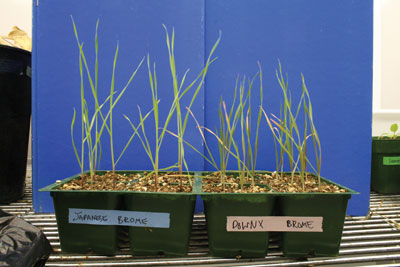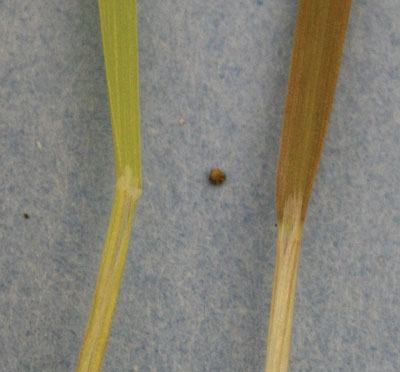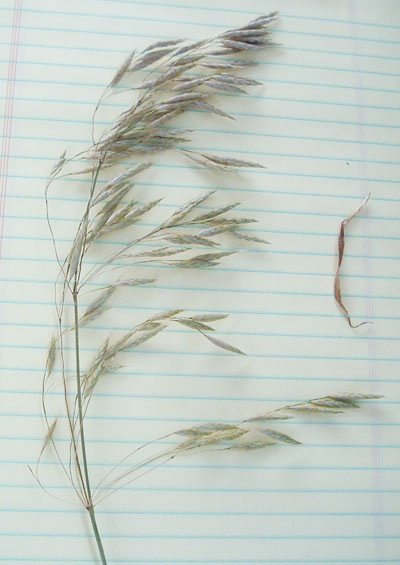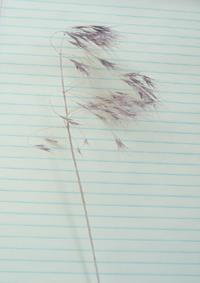
News
Know your brome weed species
Japanese brome (Bromus japonicus) and downy brome (Bromus tectorum ) are often confused in the field, and across the Prairies they may be called by different names in different regions.
May 4, 2009 By Bruce Barker
Japanese brome (Bromus japonicus) and downy brome (Bromus tectorum ) are often confused in the field, and across the Prairies they may be called by different names in different regions. Sometimes cheat (Bromus secalinus L.) is even an occasional interloper into the Prairies. Here is how to tell the difference between the commonly named brome grasses. And when in doubt, use the botanical name. “Terminology has been a problem with brome grass weed species. They are often just referred to as cheatgrass. That’s different than “cheat”, and I don’t believe there is much Bromus secalinus on the Canadian Prairies if any at all,” says Clark Brenzil, provincial specialist in Weed Control with Saskatchewan Ministry of Agriculture in Regina. “The two main annual brome weed species are Japanese brome and downy brome.”
 |
|
| Japanese and downy brome can be difficult to distinguish from each other at the seedling stage. Photo courtesy of Clark Brenzil, SAF. |
At the seedling stage, telling the difference between Japanese brome and downy brome is difficult, as both species form shoots in a cluster arising from a crown. While each species may act as either an annual or winter annual, and both flower from May to July when acting as a winter annual, field observations across the Canadian Prairies suggest that Japanese brome is found more often growing as an annual among spring seeded crops and flowering well into July as a result.
One of the differences that can be picked up in the field is a difference in ligules. A ligule is a small, thin and often hairy or membranous growth at the junction of the leaf and stem. The ligule is found where the leaf attaches to the main stem and continues to clasp the stem as the leaf blade diverges away from the stem. The serrations on Japanese brome ligules end in a more blunt point than the more pointed serration endings of down brome.
Identification easier towards maturity
Brenzil explains that in later growth phases, Japanese brome has much finer leaves and is a finer looking plant. Japanese brome can often be confused with Persian darnel in areas where their ranges overlap since the general architecture of the two plants is so similar just prior to flowering. Closer observation easily distinguishes Japanese brome from Persian darnel as the former is hairy and the darnel is not and has a shiny underside to the leaf. Japanese and downy brome grow to similar heights, but when the plants produce heads and start to flower, identification becomes easier.
 |
|
| The ligules on Japanese brome (Left) have a blunter point than downy brome (right). Photo courtesy of Clark Brenzil, SAF. |
At flowering time, while the panicles themselves are roughly the same size and architecture, the panicles of Japanese brome are somewhat less drooping than those of downy brome that can bend nearly downward again. The spikelets of Japanese brome are more compact whereas those of downy brome are more open.
The awn on the seed of Japanese brome is equal or shorter than its seed and curls when mature. As a result, the awn points outward, perpendicular to the spikelet. The spikelet has an appearance similar to a miniature wheat head.
Conversely, the awn on a downy brome seed is straight, distinctly longer than the seed and grows straight out from the tip of the seed. This combined with the more loose arrangement of the florets/seeds in the spikelet gives it the appearance of a series of Vs stacked on top of another.
Downy brome often expresses more purple colour in both the vegetative and mature phases, and the seeds are reddish-purple. Japanese brome often stays green during the vegetative and tan when mature. The seeds of Japanese brome are also tan in colour.
Brenzil cautions, though, not to rely on colour too much. “A lot of environmental factors can cause colour to be expressed differently, so it is not the biggest determining factor that farmers and agronomists should look for.”
 |

|
| Japanese brome (Bromus japonicus) has short awns and a more upright head. | Downy brome (Bromus tectorum) has a dropping head and longer awns. Photo courtesy of North Dakota State University. |